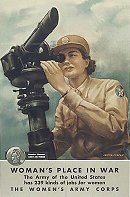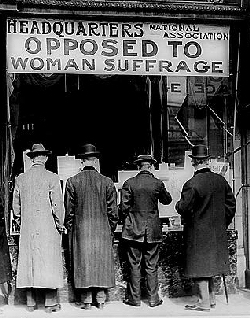
GENDER AND SOCIETY
"Men have always been afraid that women could get along without them."
--Margaret Mead
In addition to age, gender is one of the universal
dimensions on which status differences are based. Unlike sex, which is
a biological concept, gender is a social
construct specifying the socially and culturally prescribed roles that
men and women are to follow. According to Gerda Lerner in The Creation
of Patriarchy, gender is the "costume, a mask, a straitjacket
in which men and women dance their unequal dance" (p.238). As Alan
Wolfe observed in "The Gender Question" (The New Republic,
June 6:27-34), "of all the ways that one group has systematically
mistreated another, none is more deeply rooted than the way men have subordinated
women. All other discriminations pale by contrast." Lerner argues
that the subordination of women preceded all other subordinations and that
to rid ourselves of all of those other "isms"--racism, classism,
ageism, etc.--it is sexism that must first be eradicated. For some
specifics, see B. Deutsch's "The
Male Privilege Checklist" and Nijole Benokraitis & Joe Feagin's "Overt/Subtle/Covert
Sex Discrimination: An Overview."
Women have always had lower status than men, but the
extent of the gap between the sexes varies across cultures and time (some
arguing that it is inversely related to social evolution). In 1980, the
United Nations summed up the burden of this inequality: Women, who comprise
half the world's population, do two thirds of the world's work, earn one
tenth of the world's income and own one hundredth of the world's property.
In Leviticus, God told Moses that a man is worth 50 sheikels and a woman
worth 30--approximately
the contemporary salary differentials of the sexes in the United
States. (Actually, according to one "Current
Population Survey" of the US Census Bureau, American women in 1999
earned approximately 77% of what men made, in 2000, according to the Department
of Labor, their median weekly
earnings were 76% of the male median.) What might be the socio-cultural implications if men were to
also be the child bearers? Follow the first human male pregnancy (well,
not really) at www.malepregnancy.com.

And the significance of the stamps above? A recent
U.S. Postal Service publication, "Women on Stamps",
holds some interesting methodological possibilities. Putting a deceased individual's likeness on
a stamp is one way by which political immortality is
conferred. Of the hundreds of Americans so immortalized only a handful are women: 16, to be
precise, through 1960; 19 through 1970; and 29 through 1980 (any connection between this
50% increase with the ERA movement of the seventies?). An enterprising student may wish to
investigate and compare how this female proportion of immortalized citizens varies across
countries and time.
 Matters of gender are scattered throughout these pages,
including gender differences in household duties,
in in voting during the 1996 Presidential election,
and in suicide rates cross-nationally. Take
advantage of this site's search engine by first
entering "gender" and next "sex" as the search words.
Matters of gender are scattered throughout these pages,
including gender differences in household duties,
in in voting during the 1996 Presidential election,
and in suicide rates cross-nationally. Take
advantage of this site's search engine by first
entering "gender" and next "sex" as the search words.
- The State of the World Population 2000: Lives Together, Worlds Apart--Men and Women in a Time of Change from the United Nations Population Fund
- GenderNet from the World Bank. Extensive international
datasets

HOW MUCH HAS
CHANGED?
According
to Gallup surveys, in 1946 Americans felt by a margin of 54% to 24%
that women live more difficult lives than men. More than one-half century
later that margin had increased to 57% to 17%, with most of that change
owing to increasing agreement among men (from a 47%-27% margin in 1946
to 52%-19% in 1997).
In the 1930s, 26 of 48 states had laws prohibiting the employment of married
women. (It was the midst of the Great Depression and there were not enough jobs to keep the
men out of political mischief, so married women had to go.) Click here to see Belief that a woman's place is in the home by cohort and education,
1977-94
- The National Women's History
Project's "Living the Legacy: The Women's Rights Movement 1848-1998" and its
links to resource sites
- The
Virtual Library on Labour and Business History has a sizable
listing of women history
journals
- National Museum of Women's
History, with featured exhibit: "Motherhood, social service and political reform: The
political culture and imagery of American suffrage"
- Women's History Workshop a collaborative effort of Massachusetts
middle school through
college teachers

- Ken Middleton's
American Women's History: A Research Guide
- Women in American History--from
Encyclopedia Britannica
- Diotima: Materials on Women and Gender in the Ancient World includes
bibliographical lists on such wide-ranging subjects as athletics, death, rape, ancient medicine, law,
prostitution, and magic
- ViVa: A Bibliography of Women's History in Historical and Women's
Studies Journals
- Library
of Congress/American Memory's Selections from the National American Women
Suffrage Association Collection, 1848-1921
- Library
of Congress/American Memory's "Votes for Women" Suffrage Pictures,
1850-1920

- UC Berkeley Library's
Suffragists Oral History Project
- Thomas Dublin and Kathryn Kish Sklar's Women and Social Movements in the United
States, 1775-2000 (SUNY Binghamton project posing questions and providing primary
documents to answer them)
- Suffragists
Oral History Project (UC Berkeley's Bancroft Library)
- Duke
University's
"Women's Studies (R)E-sources on the Web"
- From Smith College, the Sophia Smith Collection, "an internationally recognized repository of manuscripts, photographs,
periodicals and other primary sources in women's history"
- Phyllis Holman Weisband's (U. Wisconsin) Selected Women and Gender Resources"
- Voice of
the Shuttle: Gender Studies Page
- University of
Maryland (Baltimore County) Women's Studies Homepage: routinely updated
links to gender- related websites and electronic forums
-
Washington Post series "Gender
Roles in the '90s"
-
Internet Resources for Women's Legal and Public Policy Information

HOW MUCH CHANGE NEEDS TO BE MADE
The 2006 International Women's Day brought alarming messages from Latin
American delegates about the growing rate of "femicide" in their countries.
In Guatemala, for instance, more than 2,300 women had been brutally murdered.
Observed Indira Lakshmanan in the Boston Globe (March 30,
2006), "Housewives, teenagers, and college students have disappeared and
later been found naked, disemboweled, sexually mutilated, beheaded, and dumped
in abandoned lots." Similar stories have come from Brazil, Colombia, Peru, and
Mexico.
- Prevalence Rates for
Female Genital Mutilation, 2001
- From Human Rights Watch, "We Want to Live as Humans: Repression of
Women and Girls in Western Afghanistan" (Dec. 2002)
- Yahoo's collection of Sexual Harassment sites
- Rape
- History
of Rape
- WHO's Violence Against Women with
national-level statistics on percentage of women physically assaulted by an intimate partner
- Men
and Domestic Violence Index
GETTING REALLY
HISTORICAL (AND CROSS-CULTURAL)
- Chris Witcombe's "Images of Women in Ancient Art: Issues of Interpretation and Identity"

- Ken Middleton's American
Women's History: A Research Guide
- Women
and Gender in Ancient Egypt (from University of Michigan's Kelsey Museum)
- Universes in Collision:
Men and Women in 19th-Century Japanese Prints (University of Virginia)
HERSTORY:
RETHINKING HISTORY FROM FEMALES'
PERSPECTIVES
- National Women's Hall of Fame
INSTITUTIONAL ANALYSES
EDUCATION
You've probably read the studies showing how as the proportion of women in an occupational/professional category
increases average earnings go down. Well what happens when women become
"winners" in that institution that legitimates claims to the
best positions in the work world: higher education? According to
Business Roundtable (June 2003), in 1999-2000, women received 133 bachelor's
degrees for every 100 to men. A decade later, during the 2009-2010
school year, women are projected to receive 142 bachelor's degrees for every
100 for men. What will happen to the "value" of a college
degree?
- From the National Center for Education Statistics, "Gender Differences in Participation and Completion of Undergraduate Education
and How They Have Changed Over Time" (2005)
FAMILY
- Gender inequalities in family times
- The plight of mothers of young children: To work or not to work?

MASS MEDIA
 Gender biases and stereotypes are amply reinforced in the mass media. In newspapers, for instance, men received three-quarters of
the front-page references and appeared in two-thirds of the front-page pictures in the mid-1990s.
The United Nations
Division for the Advancement of Women included in its
Beijing
Declaration and Platform for Action the observation how the "continued
projection of negative and degrading images of women in media communications -
electronic, print, visual and audio - must be changed. Print and electronic
media in most countries do not provide a balanced picture of women's diverse
lives and contributions to society in a changing world. In addition, violent and
degrading or pornographic media products are also negatively affecting women and
their participation in society." Mediascope's "Violence, Women and the
Media" cites mounting evidence how "negative perceptions of women in entertainment can affect women in real life."
Gender biases and stereotypes are amply reinforced in the mass media. In newspapers, for instance, men received three-quarters of
the front-page references and appeared in two-thirds of the front-page pictures in the mid-1990s.
The United Nations
Division for the Advancement of Women included in its
Beijing
Declaration and Platform for Action the observation how the "continued
projection of negative and degrading images of women in media communications -
electronic, print, visual and audio - must be changed. Print and electronic
media in most countries do not provide a balanced picture of women's diverse
lives and contributions to society in a changing world. In addition, violent and
degrading or pornographic media products are also negatively affecting women and
their participation in society." Mediascope's "Violence, Women and the
Media" cites mounting evidence how "negative perceptions of women in entertainment can affect women in real life."
One way, of course, to counter such phenomena is giving women control over media messages. From the University of Maryland comes
Women in Broadcasting History.
For feminist perspectives on the news:
-
Feminist.com
- Ms. Magazine
- Global Women's Issues
WORK
- Joan Korenman's
annotated links (University of Maryland-Baltimore County)
- U.S. Department of Labor:
Women's Bureau Home Page
- International Labour Organization's
Gender Web Site
- From the Harvard University Library Open Collections Program:
Women Working, 1870-1930
- Diane Elson and Caroline Wright's
Gender Issues in Contemporary Industrialization: An Annotated Bibliography.
- Global Women's Rights--
resources on the impact of globalization on women in the developing world
- Bill Moyers' NOW's "Rich World, Poor Women" (Fall, 2003)
- The
Glass Ceiling Commission
-
University of Maryland's Women's Studies Database and Gender Issues:
Women in the Workforce
- WOW! Work of Women
WOMEN IN THE MILITARY: EQUALITY TO KILL (AND TO BE KILLED)

Owing to labor shortages during World War II, all military branches were enlisting women by late
1942. Their entry into these and other supposedly traditional male spheres of
life triggered considerable controversy. One
church argued that the Women's Army Corps was "intended to break down the traditional American and Christian opposition to
removing women from the home…by bringing back the pagan female goddess of
de-sexed, lustful sterility."
In the NORC 1982
General
Social Survey Americans were asked whether they think a woman should or
should not be assigned as a soldier in hand-to-hand combat assuming she is
trained to do it (variable FINDLND)?
PERCENT MEN AND WOMEN SAYING WOMEN SHOULD BE ASSIGNED TO COMBAT ROLES
| BIRTH COHORT: |
pre-1910 |
1910-19 |
1920-29 |
1930-39 |
1949-49 |
1950 on |
TOTAL |
| FEMALE |
17% |
21% |
34% |
35% |
43% |
58% |
38% |
| MALE |
22% |
15% |
17% |
34% |
36% |
36% |
30% |

In total, observe in the right-most column how women were 8
percentage points more likely than men to believe that women should be assigned
to combat roles. This total, however, does not reflect some interesting
generational dynamics at work. For men, the big divide is between those
born before and after 1930--those roughly older or younger than 50 years of age
in 1982, with the latter about twice as likely as their older counterparts to
favor such assignment. For women, support consistently decreases with
age. Their big generational breaks occur between those born before and
after women first exercised their right to vote in 1920, and between those born
before and after the Korean War. Finally, observe how the sexes most
differ in attitude immediately after these generational divides: among
those born in the 1920s and in the 1950s. (Not revealed in this table is how
support within both sexes declined between those born in the 1950s and 1960s,
with a 9 percentage point decline for women and 4 for men.)
Twelve years after this question was presented to the American public, in 1994, President
Bill Clinton signed an order allowing women on combat ships and aircraft. Thirteen servicewomen died during
the 1991 Gulf War, four from enemy fire, and 21 were wounded in action. In
the 2003 Gulf War, women made up one in seven of the military personnel in
Iraq.
POLITICS AND GLOBALIZATION
OF GENDER
- Institute for Women's Policy Research--"IWPR
focuses on issues of poverty and welfare, employment and earnings,
work and family issues, health and safety, and women's civic and
political participation."
-
- WomensNet/IGC
-
- 4th WORLD
CONFERENCE ON WOMEN site
-
- Women in National Parliaments
-
- Fall
1996 issue of Indiana Journal of Global Legal Studies on Feminism
and Globalization
-
- UC Davis's Gender and Global Issues Program
FEMINISM AND ITS
BACKLASH
Among the questions asked in the NORC
1996 General Social Survey were the following:
- Do you think of yourself as a feminist or not? Twelve
percent of men and 29% of women responded "yes." Among women,
there was no significant difference among age groups; interestingly, women
in their fifties and seventy and older were most likely to identify themselves
as feminists while those in their thirties and sixties were least likely
to do so. Women with four or more years of college were about 40 percent
more likely to think of themselves as feminists than those with less education.
This relationship, however, varies by race: While increasing education
is associated with increasing identification among white women, among African
American women the greatest identification was among the least educated
(40% of black women who did not graduate from high school considered themselves
feminists, as opposed to 19% of white women; among women with four or more
years of college, 38% of whites compared to 27% blacks thought of themselves
as feminists).
- We'd like your views on how the women's movement has
affected certain groups. For each group I name, please tell me whether
you thing the women's movement has improved their lives, made their lives
worse, or had no effect on their lives: homemakers (variable HOMEMAKER),
women with working class jobs (WRKCLASS), women with management or professional
jobs (MANPROF), men (MEN), children (CHILDREN), your self
(YOURSELF).
Below are responses to these questions broken down
by sex:
|
HOMEMAKER |
WRKCLASS |
MANPROF |
MEN |
CHILDREN |
YOURSELF |
|
M |
F |
M |
F |
M |
F |
M |
F |
M |
F |
M |
F |
| IMPROVED |
43% |
42% |
79% |
80% |
85% |
88% |
32% |
32% |
41% |
46% |
28% |
47% |
| NO EFFECT |
37 |
34 |
14 |
15 |
9 |
8 |
41 |
32 |
23 |
25 |
66 |
49 |
| MADE WORSE |
20 |
24 |
7 |
5 |
6 |
4 |
27 |
36 |
36 |
29 |
6 |
4 |

- Feminist
Majority
Foundation
- Feminism
and Women's Studies links from Carnegie Mellon's English Servers humanities
texts online
- Kirstin Switala's Feminist Theory Website (Virginia Tech)
- Joan Korenman's Women's Studies/Women's Issues Resource Sites
(University of Maryland, Baltimore County)
- Feminist resources from WWWomen.Com
- Gender-Neutral Pronoun Frequently Asked Questions
(John Williams)
- The
Backlash! Men's
issues & fathers' rights


ORGANIZING FOR
CHANGE
- Independent Women's Forum
"to advance the American spirit of enterprise and self-reliance and to support
the principles of political freedom, economic liberty, and personal
responsibility among women." Site includes Weird Science and Docket Watches
along with SheThinks
magazine, which is "by and for college students who feel academically
isolated and disenchanted with a feminist movement that seems bent on problems
instead of solutions."
- National
Organization
for Women (NOW) Home Page
- 4th
WORLD CONFERENCE ON WOMEN site and a follow
up
EXPECTATIONS FOR THE
FUTURE
In the NORC 1996
General
Social Survey Americans were asked "Think about girls growing
up today: Do you think their chances for a happy family life will be better
than yours, about the same, or worse than yours?" (variable HAPGIRLS)
Their predictions were not that rosy: Only 20% thought their chances will
be better while 36% thought that they will be worse.
PERCENT OF AMERICANS BELIEVING GIRLS' CHANCES FOR HAPPY
FAMILY LIFE
WILL BE WORSE THAN ONE'S OWN, BY SEX, AGE, AND
EDUCATION
|
MEN |
WOMEN |
|
0-11
YEARS |
HS
GRAD |
SOME
POST
SECONDARY |
4+ YRS
COLLEGE |
0-11
YEARS |
HS
GRAD |
SOME
POST
SECONDARY |
4+ YRS
COLLEGE |
TOTAL |
| 18-35 |
62 |
25 |
25 |
19 |
46 |
30 |
38 |
26 |
31 |
| 36-45 |
46 |
28 |
38 |
31 |
37 |
40 |
31 |
24 |
33 |
| 46-64 |
39 |
27 |
39 |
38 |
33 |
36 |
43 |
34 |
37 |
| 65+ |
44 |
47 |
71 |
58 |
54 |
45 |
48 |
46 |
56 |
| TOTAL |
46 |
30 |
37 |
33 |
44 |
38 |
38 |
29 |
36 |
MEN'S STUDIES
- XY: Men, Masculinities, and Gender Politics

 Return to A Sociological Tour Through
Cyberspace
Return to A Sociological Tour Through
Cyberspace
 Matters of gender are scattered throughout these pages,
including gender differences in household duties,
in in voting during the 1996 Presidential election,
and in suicide rates cross-nationally. Take
advantage of this site's search engine by first
entering "gender" and next "sex" as the search words.
Matters of gender are scattered throughout these pages,
including gender differences in household duties,
in in voting during the 1996 Presidential election,
and in suicide rates cross-nationally. Take
advantage of this site's search engine by first
entering "gender" and next "sex" as the search words. 






 Gender biases and stereotypes are amply reinforced in the mass media. In newspapers, for instance, men received three-quarters of
the front-page references and appeared in two-thirds of the front-page pictures in the mid-1990s.
The United Nations
Division for the Advancement of Women included in its
Beijing
Declaration and Platform for Action the observation how the "continued
projection of negative and degrading images of women in media communications -
electronic, print, visual and audio - must be changed. Print and electronic
media in most countries do not provide a balanced picture of women's diverse
lives and contributions to society in a changing world. In addition, violent and
degrading or pornographic media products are also negatively affecting women and
their participation in society." Mediascope's "Violence, Women and the
Media" cites mounting evidence how "negative perceptions of women in entertainment can affect women in real life."
Gender biases and stereotypes are amply reinforced in the mass media. In newspapers, for instance, men received three-quarters of
the front-page references and appeared in two-thirds of the front-page pictures in the mid-1990s.
The United Nations
Division for the Advancement of Women included in its
Beijing
Declaration and Platform for Action the observation how the "continued
projection of negative and degrading images of women in media communications -
electronic, print, visual and audio - must be changed. Print and electronic
media in most countries do not provide a balanced picture of women's diverse
lives and contributions to society in a changing world. In addition, violent and
degrading or pornographic media products are also negatively affecting women and
their participation in society." Mediascope's "Violence, Women and the
Media" cites mounting evidence how "negative perceptions of women in entertainment can affect women in real life."




